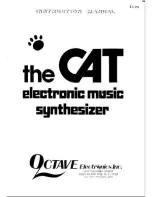
Appendix
78
M Manual
signal that is generated and the diagonal line in the graphic
shows the attack stage over time.
As soon as you play a note the envelope moves through the
wavetable positions generating different waveforms over
time.
The decay stage would move through these waves in the
opposite direction while ultimately holding a certain wave
at its sustain stage. When you release the note, the envelo-
pe decays to zero.
Most wavetables are created so that they start with a hol-
low wave at position 0 and go through increasingly brigh-
ter waves up to maximum position. This results in a beha-
viour similar to a low pass filter so that they can be conve-
niently controlled by an envelope.
If Attack is 0 and Decay set to a medium value you get a
percussive sound; if you turn up the attack, you get a soft-
sounding start.
You can also use an LFO to modulate the wavetable positi-
on and, depending on the selected
LFO Shape
, you might
get a wave scanning that goes back and forth (triangle)
only into one direction followed by a hard reset to the
origin (triangle with maximum Symmetry) or between
only two waves (square).
Exceeded Waves of a Wavetable
Of course you can combine envelope and keytrack modula-
tions or add other modulation sources. All these modulati-
ons will be added so that maybe the end or the beginning
of a wavetable could be exceeded.
!"
#$
%&
'(
)
*+,-
./0121/3
45331367289/568728-
-3,-:/;-7+22+<=702+6-
6-3-9+2-5>1/70163+:
?1@-
Содержание M
Страница 1: ...User Manual ...








































